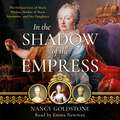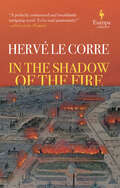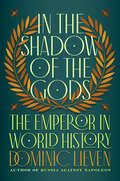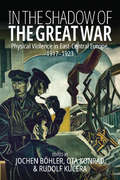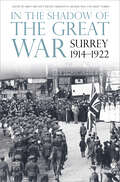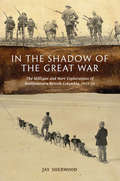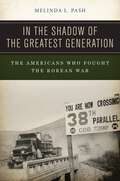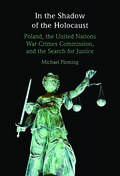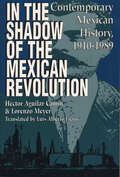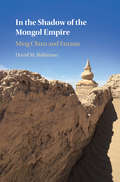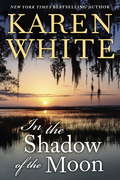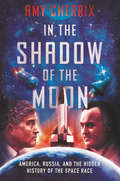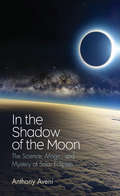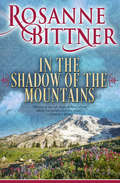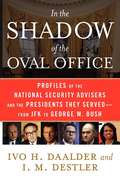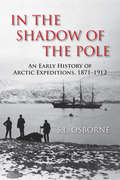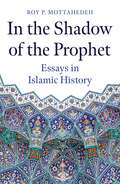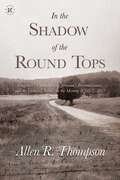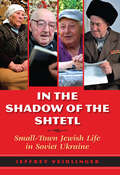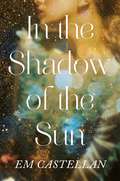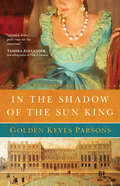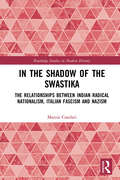- Table View
- List View
In the Shadow of the Empress: The Defiant Lives of Maria Theresa, Mother of Marie Antoinette, and Her Daughters
by Nancy GoldstoneOut of the thrilling and tempestuous eighteenth century comes the sweeping family saga of beautiful Maria Theresa, a sovereign of extraordinary strength and vision, the only woman ever to inherit and rule the vast Habsburg empire in her own name, and three of her remarkable daughters: lovely, talented Maria Christina, governor-general of the Austrian Netherlands; spirited Maria Carolina, the resolute queen of Naples; and the youngest, Marie Antoinette, the glamorous, tragic queen of France, perhaps the most famous princess in history. Unfolding against an irresistible backdrop of brilliant courts from Vienna to Versailles, embracing the exotic lure of Naples and Sicily, this epic history of Maria Theresa and her daughters is a tour de force of desire, adventure, ambition, treachery, sorrow, and glory.Each of these women's lives was packed with passion and heart-stopping suspense. Maria Theresa inherited her father's thrones at the age of twenty-three and was immediately attacked on all sides by foreign powers confident that a woman would to be too weak to defend herself. Maria Christina, a gifted artist, who alone among her sisters succeeded in marrying for love, would face the same dangers that destroyed the monarchy in France. Resourceful Maria Carolina would usher in the golden age of Naples only to then face the deadly whirlwind of Napoleon. And, finally, Marie Antoinette, the doomed queen whose stylish excesses and captivating notoriety have masked the truth about her husband and herself for two hundred and fifty years.
In the Shadow of the Fallen Towers: The Seconds, Minutes, Hours, Days, Weeks, Months, and Years after the 9/11 Attacks
by Don BrownExcellence in Nonfiction for Young Adults FinalistA graphic novel chronicling the immediate aftermath and rippling effects of one of the most impactful days in modern history: September 11, 2001. From the Sibert Honor– and YALSA Award–winning creator behind The Unwanted and Drowned City. The consequences of the terrorist attack on the World Trade Center in New York City, both political and personal, were vast, and continue to reverberate today. Don Brown brings his journalistic eye and attention to moving individual stories to help teens contextualize what they already know about the day, as well as broaden their understanding of the chain of events that occurred in the attack’s wake.Profound, troubling, and deeply moving, In the Shadow of the Fallen Towers bears witness to our history—and the ways it shapes our future.
In the Shadow of the Fire
by Hervé Le CorreAs the Paris Commune is destroyed, a Communard searches the embattled city for his missing fiancé in this prize-winning novel: “an astounding epic” (L’Express, FR).Paris, 1871. The Paris Commune has taken control of the French capitol, but the Communards now face a savage conflict against the French Armed Forces loyal to Versailles in what will come to be known as The Bloody Week. Amid the shrapnel and chaos, while the entire west side of Paris is a field of ruins, a photographer fascinated by the suffering of young women takes “suggestive” photos to sell to a particular clientele.Then young women begin disappearing, and when a seamstress who volunteers at a first aid station, is counted among the missing, her fiancé—a member of the Commune’s National Guard—scours the city for her. Joined in the search by a Communal security officer, their race against the clock takes them through the shell-shocked streets of Paris, and introduces them to a cast of fascinating characters.Winner of the French Voices Prize
In the Shadow of the Gods: The Emperor in World History
by Dominic LievenA dazzling account of the men (and occasional woman) who led the world&’s empires, a book that probes the essence of leadership and power through the centuries and around the world.From the rise of Sargon of Akkad, who in the third millennium BCE ruled what is now Iraq and Syria, to the collapse of the great European empires in the twentieth century, the empire has been the dominant form of power in history. Dominic Lieven&’s expansive book explores strengths and failings of the human beings who held those empires together (or let them crumble). He projects the power, terror, magnificence, and confidence of imperial monarchy, tracking what they had in common as well as what made some rise to glory and others fail spectacularly, and at what price each destiny was reached.Lieven&’s characters—Constantine, Chinggis Khan, Trajan, Suleyman, Hadrian, Louis XIV, Maria Theresa, Peter the Great, Queen Victoria, and dozens more—come alive with color, energy, and detail: their upbringings, their loves, their crucial spouses, their dreadful children. They illustrate how politics and government are a gruelling business: a ruler needed stamina, mental and physical toughness, and self-confidence. He or she needed the sound judgement of problems and people which is partly innate but also the product of education and experience. A good brain was essential for setting priorities, weighing conflicting advice, and matching ends to needs. A diplomatically astute marriage was often even more essential. Emperors (and the rare empresses) could be sacred symbols, warrior kings, political leaders, chief executive officers of the government machine, heads of a family, and impresarios directing the many elements of "soft power" essential to any regime&’s survival. What was it like to live and work in such an extraordinary role? What qualities did it take to perform this role successfully? Lieven traces the shifting balance among these elements across eras that encompass a staggering array of events from the rise of the world&’s great religions to the scientific revolution, the expansion of European empires across oceans, the great twentieth century conflicts, and the triumph of nationalism over imperialism.The rule of the emperor may be over, but Lieven shows us how we live with its poltical and cultural legacies today.
In the Shadow of the Great War: Physical Violence in East-Central Europe, 1917–1923
by Jochen Böhler Ota Konrád And Rudolf KučeraWhether victorious or not, Central European states faced fundamental challenges after the First World War as they struggled to contain ongoing violence and forge peaceful societies. This collection explores the various forms of violence these nations confronted during this period, which effectively transformed the region into a laboratory for state-building. Employing a bottom-up approach to understanding everyday life, these studies trace the contours of individual and mass violence in the interwar era while illuminating their effects upon politics, intellectual developments, and the arts.
In the Shadow of the Great War: Physical Violence in East-Central Europe, 1917–1923
by Jochen Böhler, Ota Konrád, and Rudolf KučeraWhether victorious or not, Central European states faced fundamental challenges after the First World War as they struggled to contain ongoing violence and forge peaceful societies. This collection explores the various forms of violence these nations confronted during this period, which effectively transformed the region into a laboratory for state-building. Employing a bottom-up approach to understanding everyday life, these studies trace the contours of individual and mass violence in the interwar era while illuminating their effects upon politics, intellectual developments, and the arts.
In the Shadow of the Great War: Surrey, 1914-1922
by Michael Page Kirsty Bennett Imogen Middleton Juliet WarrenThe military toll of World War I is widely known: millions of Britons were mobilised, many thousands killed or wounded, and the landscape of British society changed forever. But how was the conflict experienced by the people of Surrey on the home front? Surrey Heritage’s project Surrey in the Great War: A County Remembers has, over the four-year centenary commemoration, explored the wartime stories of Surrey’s people and places. The project’s discoveries are here captured through text, case studies and images. This book chronicles the mobilisation of Surrey men, the training of foreign troops in the county, objection to military service, defence against invasion, voluntary work and fundraising, the experiences of women and children, shortages, industrial supply to the armed forces and the commemoration of Surrey’s dead. Drawing heavily on the rich archives of Surrey Heritage, it is an engaging exploration of a county in the shadow of the first globalised war between industrialised nations.
In the Shadow of the Great War: The Milligan and Hart Explorations of Northeastern British Columbia, 1913–14
by Jay SherwoodIn 1913, the BC government hired G.B. Milligan and E.B. Hart to each lead a small expedition that spent 18 months exploring the northeastern part of British Columbia. These expeditions helped provide the first detailed information of this region. Unfortunately, World War I began just as these men completed their work, and the information they gathered got filed away and forgotten in the shadow of the Great War. Now, on the centennial of these expeditions, historian Jay Sherwood's new book documents the Milligan and Hart expeditions. He reveals what their expeditions accomplished and he shows readers what northern BC was like 100 years ago.
In the Shadow of the Greatest Generation: The Americans Who Fought the Korean War
by Melinda L. PashLargely overshadowed by World War II’s “greatest generation” and the more vocal veterans of the Vietnam era, Korean War veterans remain relatively invisible in the narratives of both war and its aftermath. Yet, just as the beaches of Normandy and the jungles of Vietnam worked profound changes on conflict participants, the Korean Peninsula chipped away at the beliefs, physical and mental well-being, and fortitude of Americans completing wartime tours of duty there. Upon returning home, Korean War veterans struggled with home front attitudes toward the war, faced employment and family dilemmas, and wrestled with readjustment. Not unlike other wars, Korea proved a formative and defining influence on the men and women stationed in theater, on their loved ones, and in some measure on American culture. In the Shadow of the Greatest Generation not only gives voice to those Americans who served in the “forgotten war” but chronicles the larger personal and collective consequences of waging war the American way.
In the Shadow of the Holocaust: Poland, the United Nations War Crimes Commission, and the Search for Justice
by Michael FlemingIn the midst of the Second World War, the Allies acknowledged Germany's ongoing programme of extermination. In the Shadow of the Holocaust examines the struggle to attain post-war justice and prosecution. Focusing on Poland's engagement with the United Nations War Crimes Commission, it analyses the different ways that the Polish Government in Exile (based in London from 1940) agitated for an Allied response to German atrocities. Michael Fleming shows that jurists associated with the Government in Exile made significant contributions to legal debates on war crimes and, along with others, paid attention to German crimes against Jews. By exploring the relationship between the UNWCC and the Polish War Crimes Office under the authority of the Polish Government in Exile and later, from the summer of 1945, the Polish Government in Warsaw, Fleming provides a new lens through which to examine the early stages of the Cold War.
In the Shadow of the Mexican Revolution: Contemporary Mexican History, 1910-1989 (LLILAS Translations from Latin America Series)
by Héctor Aguilar Camín Lorenzo Meyer translated by Luis Alberto FierroHector Aguilar Camin and Lorenzo Meyer, two of Mexico's leading intellectuals, set out to fill a void in the literature on Mexican history: the lack of a single text to cover the history of contemporary Mexico during the twentieth century. A la sombra de la Revolucion Mexicana, now available in English as In the Shadow of the Mexican Revolution, covers the Mexican Revolution itself, the gradual consolidation of institutions, the Cardenas regime, the "Mexican economic miracle" and its subsequent collapse, and the recent transition toward a new historical period. The authors offer a comprehensive and authoritative study of Mexico's turbulent recent history, a history that increasingly intertwines with that of the United States. Given the level of interest in Mexico-likely to increase still more as a result of the recent liberalization of trade policies-this volume will be useful in affording U. S. readers an intelligent, comprehensive, and accessible study of their neighbor to the south. "
In the Shadow of the Mexican Revolution: Contemporary Mexican History, 1910–1989 (LLILAS Translations from Latin America Series)
by Héctor Aguilar Camín Lorenzo MeyerAn authoritative and comprehensive history of post-revolutionary Mexico by two of the country’s leading intellectuals.Héctor Aguilar Camín and Lorenzo Meyer set out to fill a void in the literature on Mexican history: the lack of a single text to cover the history of Mexico during the twentieth century. In the Shadow of the Mexican Revolution, covers the Mexican Revolution itself, the gradual consolidation of institutions, the Cárdenas regime, the “Mexican economic miracle” and its subsequent collapse, and the recent transition toward a new historical period.The authors explore Mexico’s turbulent recent history as it becomes increasingly intertwined with that of the United States. First published in Spanish as A la sombra de la Revolución Mexicana, this English-language edition offers US readers an intelligent and accessible study of their neighbor to the south.
In the Shadow of the Mongol Empire: Ming China and Eurasia
by David M. RobinsonDuring the thirteenth century, the Mongols created the greatest empire in human history. Genghis Khan and his successors brought death and destruction to Eurasia. They obliterated infrastructure, devastated cities, and exterminated peoples. They also created courts in China, Persia, and southern Russia, famed throughout the world as centers of wealth, learning, power, religion, and lavish spectacle. The great Mongol houses established standards by which future rulers in Eurasia would measure themselves for centuries. In this ambitious study, David M. Robinson traces how in the late fourteenth century the newly established Ming dynasty (1368–1644) in China crafted a narrative of the fallen Mongol empire. To shape the perceptions and actions of audiences at home and abroad, the Ming court tailored its narrative of the Mongols to prove that it was the rightful successor to the Mongol empire. This is a story of how politicians exploit historical memory for their own gain.
In the Shadow of the Moon
by Karen WhiteRevisit the beginning of New York Times bestselling author Karen White’s signature style in one of her earliest novels—a story about a love that defies time... IN THE SHADOW OF THE MOONWhen Laura Truitt first sees the dilapidated plantation house, she’s overcome by a sense of familiarity. Inside, the owner claims to have been waiting for years and offers an old photograph of a woman with Laura’s face. Soon afterwards, when a lunar eclipse inexplicably thrusts Laura back in time to Civil War Georgia, she finds herself fighting not just for her heart, but for her very survival…. Includes an exclusive preview of Karen White’s next hardcover.
In the Shadow of the Moon: America, Russia, and the Hidden History of the Space Race
by Amy CherrixAn exhilarating dive into the secret history of humankind’s race to the moon, from acclaimed author Amy Cherrix. This fascinating and immersive read is perfect for fans of Steve Sheinkin’s Bomb and M. T. Anderson’s Symphony for the City of the Dead. You’ve heard of the space race, but do you know the whole story? The most ambitious race humankind has ever undertaken was masterminded in the shadows by two engineers on opposite sides of the Cold War—Wernher von Braun, a former Nazi officer living in the US, and Sergei Korolev, a Russian rocket designer once jailed for crimes against his country—and your textbooks probably never told you. Von Braun became an American hero, recognized the world over, while Korolev toiled in obscurity. These two brilliant rocketeers never met, but together they shaped the science of spaceflight and redefined modern warfare. From Stalin’s brutal Gulag prisons and Hitler’s concentration camps to Cape Canaveral and beyond, their simultaneous quests pushed science—and human ingenuity—to the breaking point. From Amy Cherrix comes the extraordinary hidden story of the space race and the bitter rivalry that launched humankind to the moon.
In the Shadow of the Moon: The Science, Magic, and Mystery of Solar Eclipses
by Anthony AveniFrom an award-winning author, astronomer, and anthropologist, an exploration of the scientific and cultural significance of the mesmerizing cosmic display.Since the first humans looked up and saw the sun swallowed by darkness, our species has been captivated by solar eclipses. Astronomer and anthropologist Anthony Aveni explains the history and culture surrounding solar eclipses, from prehistoric Stonehenge to Babylonian creation myths, to a confirmation of Einstein&’s theory of general relativity, to a spectacle that left New York City in the moon&’s shadow, to future eclipses that will capture human imaginations.In one accessible and engaging read, Aveni explains the science behind the phenomenon, tracks eclipses across the ancient world, and examines the roles of solar eclipses in modern times to reveal the profound effects these cosmic events have had on human history. Colored by his own experiences—Aveni has witnessed eight total solar eclipses in his lifetime—his account of astronomy&’s most storied phenomenon will enthrall anyone who has looked up at the sky with wonder.&“Aveni&’s authoritative but accessible text is the clearest statement of the way our perception of eclipses has changed over the centuries.&” —Stuart Clark, New Scientist&“Authoritative and engaging.&” —Marcelo Gleiser, NPR&’s 13.7&“A recommended way to share the spirit of the occasion.&” —Laurence A. Marschall, Natural History magazine&“Everything you need to enjoy a solar eclipse—and even predict one, just like the Babylonians did! Aveni&’s entertaining explorations show the very different impacts eclipses have had on past and present cultures.&” —David DeVorkin, National Air and Space Museum, Smithsonian Institution
In the Shadow of the Mountains
by Rosanne BittnerThe triumphs and tragedies of Denver&’s founding family as they carve out an empire in the American West—an epic saga from the beloved bestselling author. Bold, headstrong, and passionate, the indomitable Kirklands struggle to survive in a treacherous, hostile land. From penniless settlers to wealthy mine owners to Denver&’s regal first family, together—and separately—they pursue their dazzling dreams of love and glory. Through the era of the covered wagon to the rise of the western railroad, from the gold rush years through the golden age of the American West, In the Shadow of the Mountains is the breathtaking saga of a remarkable family who endured tragedy and hardship to build a glorious mountain empire. &“Bittner is one of those writers whose talent has grown over the years.&” —Publishers Weekly
In the Shadow of the Oval Office
by Ivo H. Daalder I. M. DestlerThe most solemn obligation of any president is to safeguard the nation's security. But the president cannot do this alone. He needs help. In the past half century, presidents have relied on their national security advisers to provide that help. Who are these people, the powerful officials who operate in the shadow of the Oval Office, often out of public view and accountable only to the presidents who put them there? Some remain obscure even to this day. But quite a number have names that resonate far beyond the foreign policy elite: McGeorge Bundy, Henry Kissinger, Zbigniew Brzezinski, Colin Powell, Condoleezza Rice. Ivo Daalder and Mac Destler provide the first inside look at how presidents from John F. Kennedy to George W. Bush have used their national security advisers to manage America's engagements with the outside world. They paint vivid portraits of the fourteen men and one woman who have occupied the coveted office in the West Wing, detailing their very different personalities, their relations with their presidents, and their policy successes and failures. It all started with Kennedy and Bundy, the brilliant young Harvard dean who became the nation's first modern national security adviser. While Bundy served Kennedy well, he had difficulty with his successor. Lyndon Johnson needed reassurance more than advice, and Bundy wasn't always willing to give him that. Thus the basic lesson -- the president sets the tone and his aides must respond to that reality. The man who learned the lesson best was someone who operated mainly in the shadows. Brent Scowcroft was the only adviser to serve two presidents, Gerald Ford and George H. W. Bush. Learning from others' failures, he found the winning formula: gain the trust of colleagues, build a collaborative policy process, and stay close to the president. This formula became the gold standard -- all four national security advisers who came after him aspired to be "like Brent." The next president and national security adviser can learn not only from success, but also from failure. Rice stayed close to George W. Bush -- closer perhaps than any adviser before or since. But her closeness did not translate into running an effective policy process, as the disastrous decision to invade Iraq without a plan underscored. It would take years, and another national security aide, to persuade Bush that his Iraq policy was failing and to engineer a policy review that produced the "surge." The national security adviser has one tough job. There are ways to do it well and ways to do it badly. Daalder and Destler provide plenty of examples of both. This book is a fascinating look at the personalities and processes that shape policy and an indispensable guide to those who want to understand how to operate successfully in the shadow of the Oval Office.
In the Shadow of the Pole: An Early History of Arctic Expeditions, 1871-1912
by S. L. OsborneIn the Shadow of the Pole explains how the Arctic came to be part of Canada. In the Shadow of the Pole tells the history of how the Arctic became part of Canada and how the Dominion government established jurisdiction there. It describes the early expeditions to Canada’s North, including the little-known Dominion government expeditions to the Subarctic and Arctic carried out between 1884 and 1912. The men on these expeditions conducted scientific research, meteorological studies, geological explorations, and hydrographic surveys. They informed the people they met there of Canada’s jurisdiction in the region and raised the flag from Hudson Bay to Ellesmere Island. These men endured as much hardship and adventure as Peary, Nansen, Amundsen, and other famous polar explorers, yet their expeditions were not widely publicized, and they received no glory for their efforts. This book delves into the story of the remarkable Canadian men who led these expeditions.
In the Shadow of the Prophet: Essays in Islamic History
by Roy P. MottahedehIn pieces drawn from over the course of his distinguished career, pre-eminent historian Roy Mottahedeh explores such diverse topics as the social bonds that connected people in the early Islamic Middle East, the transmission of learning in the Muslim world, religious and ethnic toleration in the past and in the present, and the theme of &‘wonders&’ in The Thousand and One Nights. His essays extend from the early Islamic period through the medieval era and on to modern times. A number concern Iran, the country of his father&’s birth, and again Mottahedeh&’s studies range widely, including Persian panegyric poetry, the origins of the city of Kashan, and Shi&‘ite political thought. Speaking to contemporary concerns, he also touches upon voting rights, academic freedom, and censorship. Intended not only for those in Islamic studies but for students of history and interested lay readers, there are introductions to each section written with the non-specialist in mind, and these sections progress from more general topics to those more specialized. In the Shadow of the Prophet thus reflects Mottahedeh&’s desire that the Islamic world and its history become better understood so that cooperation between Muslims and non-Muslims might become the order of the day.
In the Shadow of the Round Tops: Longstreet's Countermarch, Johnston's Reconnaissance, and the Enduring Battles for the Memory of July 2, 1863
by Allen R. ThompsonExciting new research lifts much of the fog surrounding the Battle of Gettysburg and offers a glimpse into what happened on that fateful day—July 2, 1863.James Longstreet&’s countermarch and Samuel Johnston&’s morning reconnaissance are two of the most enigmatic events of the Battle of Gettysburg. Both have been viewed as major factors in the Confederacy&’s loss of the battle and, in turn, the war. Yet much of it lies shrouded in mystery. Though the battle is one of the most well-documented events in history, the vast majority of our knowledge comes from the words of the veterans and civilians who experienced it. Without action photography, video, or audio recordings, our primary window into what happened is the memory of those who were there. The story of the Battle of Gettysburg is simply the compilation of the memories of those who fought it. But memory is anything but objective. Recognizing the multitude of factors that affect human memory, In the Shadow of the Round Tops explores how the individual soldiers experienced, remembered, and wrote about the battle, and how those memories have created a cloud over James Longstreet&’s enigmatic countermarch and Samuel Johnston&’s infamous reconnaissance. Each soldier had a particular view of these historic events. Because many people saw part of the story, but no one saw all of it, each memory is a critical piece to the puzzle. By comparing the veterans&’ memories and sifting through the factors that affected each memory, the picture of the countermarch, reconnaissance, and the entire battle, comes into sharper focus.
In the Shadow of the Shtetl: Small-Town Jewish Life in Soviet Ukraine
by Jeffrey VeidlingerA history based on interviews with hundreds of Ukrainian Jews who survived both Hitler and Stalin, recounting experiences ordinary and extraordinary.The story of how the Holocaust decimated Jewish life in the shtetls of Eastern Europe is well known. Still, thousands of Jews in these small towns survived the war and returned afterward to rebuild their communities. The recollections of some four hundred returnees in Ukraine provide the basis for Jeffrey Veidlinger’s reappraisal of the traditional narrative of twentieth-century Jewish history.These elderly Yiddish speakers relate their memories of Jewish life in the prewar shtetl, their stories of survival during the Holocaust, and their experiences living as Jews under Communism. Despite Stalinist repressions, the Holocaust, and official antisemitism, their individual remembrances of family life, religious observance, education, and work testify to the survival of Jewish life in the shadow of the shtetl to this day.
In the Shadow of the Sun
by EM CastellanEM Castellan's In the Shadow of the Sun is a sumptuous YA fantasy/romance novel set in 17th century Versailles.It’s 1661 in Paris, and magicians thrill nobles with enchanting illusions. Exiled in France, 17-year-old Henriette of England wishes she could use her magic to gain entry at court. Instead, her plan is to hide her magical talents, and accept an arranged marriage to the French king’s younger brother. Henriette soon realizes her fiancé prefers the company of young men to hers, and court magicians turn up killed by a mysterious sorcerer who uses forbidden magic. When an accident forces Henriette to reveal her uniquely powerful gift for enchantments to Louis, he asks for her help: she alone can defeat the dark magician threatening his authority and aid his own plans to build the new, enchanted seat of his power--the Palace of Versailles.
In the Shadow of the Sun King: A Darkness To Light Novel (book 1) (A Darkness to Light Novel #1)
by Golden Keyes ParsonsMadeleine Clavell--beautiful, fiercely faithful, and...an outlaw.As Huguenots in 17th-Century France, Madeleine Clavell and her family defy French law daily. Though they live in comfort and happiness in the French countryside, their Protestant Christianity is considered traitorous. But they are wary. Persecution is surely at hand.Then King Louis XIV's dragoons arrive, forcing the family from their country estate. Madeleine must gather her courage and seek out the king in his royal palace at Versailles.Because Madeleine has a secret. Though years and a thousand choices have separated them, Madeleine and King Louis have a history together. One she feels certain he has not forgotten. She will risk everything to speak to him again. But will the impetuous king choose to save her...and her family? And if so, at what price?
In the Shadow of the Swastika: The Relationships Between Indian Radical Nationalism, Italian Fascism and Nazism (Routledge Studies in Modern History)
by Marzia CasolariThis book examines and establishes connections between Italian Fascism and Hindu nationalism, connections which developed within the frame of Italy’s anti-British foreign policy. The most remarkable contacts with the Indian political milieu were established via Bengali nationalist circles. Diplomats and intellectuals played an important role in establishing and cultivating those tie-ups. Tagore’s visit to Italy in 1925 and the much more relevant liaison between Subhas Chandra Bose and the INA were results of the Italian propaganda and activities in India. But the most meaningful part of this book is constituted by the connections and influences it establishes between Fascism as an ideology and a political system and Marathi Hindu nationalism. While examining fascist political literature and Mussolini’s figure and role, Marathi nationalists were deeply impressed and influenced by the political ideology itself, the duce and fascist organisations. These impressions moulded the RSS, a right-wing, Hindu nationalist organisation, and Hindutva ideology, with repercussions on present Indian politics. This is the most original and revealing part of the book, entirely based on unpublished sources, and will prove foundational for scholars of modern Indian history.
